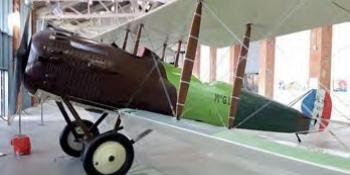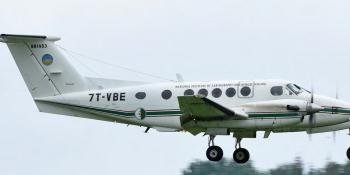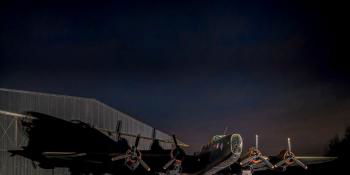Headlines from the opening days of the Farnborough Airshow 2018, this year’s largest aerospace industry exhibition



THE BIG aerospace trade shows are always the source of major news and this year’s Farnborough Airshow was no exception, with announcements in the areas of commercial and military aircraft, UAVs, engines, technology and systems.
UK bids to keep place at the pinnacle of defence after Brexit Speaking with a mock-up of an optionally manned next-generation fighter jet to be dubbed ‘Tempest’ as backdrop on the opening day of the Farnborough International Airshow, Britain’s Defence Secretary Gavin Williamson revealed a new national Combat Air Strategy (CAS) on July 16.
Williamson said he was acting to strengthen the UK’s role as a global leader in the aerospace sector and to protect key skills across the UK industrial base. The decision to build a next-generation combat air capability by 2035 is intended to demonstrate Britain’s intent to continue to be a main player on the world stage militarily and industrially.
The minister confirmed the government’s ongoing commitment to the Future Combat Air Technology Initiative, which brings together the MoD and industry partners to deliver over £2 billion of technology investment by 2025.
The strategy is intended to maintain the UK’s global leadership in combat air, provide a strong, long-term vision for the sector and potential international partners, encourage future investment and inspire the next generation.
The CAS provides a road map for the way in which the UK will balance military capability, international influence, and economic and prosperity benefit along with its overall cost.
It reinforces the commitment in the 2015 Strategic Defence and Security Review to deliver the Future Combat Air System Technology Initiative (FCAS TI).
Williamson said: “We have been a world leader in the combat air sector for a century, with an enviable array of skills and technology, and this strategy makes clear that we are determined to make sure it stays that way. It shows our allies that we are open to working together to protect the skies in an increasingly threatening future – and this concept model is just a glimpse into what the future could look like.
“[The] British defence industry is a huge contributor to UK prosperity, creating thousands of jobs in a thriving, advanced manufacturing sector and generating a UK sovereign capability that is the best in the world.
“Today’s news leaves industry, our military, the country and our allies in no doubt that the UK will be flying high in the combat air sector as we move into the next generation.”
The concept aircraft has been put together by British firms, including BAE Systems, Leonardo, MBDA and Rolls-Royce, that have joined together with the RAF Rapid Capabilities Office to form Team Tempest.
Team Tempest brings together British industry and sovereign capabilities essential for the success of future combat air’s four key technology areas: BAE Systems – advanced combat air systems and integration; Rolls-Royce – advanced power and propulsion systems; Leonardo – advanced sensors, electronics and avionics; and MBDA – advanced weapon systems.
The MoD is setting up a dedicated team to deliver a combat air acquisition programme. It must deliver a business case by the end of the year and have initial conclusions on international partners by next summer. Talks with potential partners begin immediately.
Early decisions on how to go about the new capability’s development will be confirmed by the end of 2020, and final investment decisions made by 2025. The aim is then for the next-generation platform to be operational by 2035. As the only Tier 1 partner in the worldwide F-35 programme and a leader in the four nation Eurofighter Typhoon weapon system, Britain is already at the cutting edge of advanced combat aircraft development. The skills required are rapidly perishable, so it would be foolish to let them atrophy, and the industrial spin-offs from such work are many and valuable. Other countries, including Japan and Turkey, are already exploring ways to build indigenous future combat aircraft. Chief of the Air Staff Air Chief Marshal Sir Stephen Hillier, said:
“The Combat Air Strategy will bring together the best of our people, industry and international partners to support the RAF lift-off into the next century of air power. Team Tempest demonstrates our commitment in ensuring that we continue to build our capabilities, draw upon our experience and history to bring forward a compelling vision for the next generation fighter jet.”
Norman Bone, Chairman and Managing Director of Leonardo in the UK, said: “As Britain’s national champion for advanced defence electronics, we are proud to be a part of Team Tempest. Work we have conducted under research and development programmes such as FOAS [Future Offensive Air System] and FCAS [Future Combat Air System] has significantly advanced our thinking with regards to the complex electronics required for future air combat scenarios and we stand ready to support the future needs of the Royal Air Force. We are excited about the work that’s already been done, and the work still to do, on the FCAS TI programme and are all set for these activities to feed into the Typhoon successor programme.”

Eurofighter bridge to FCAS
Eurofighter says it is planning for the continued evolution of the Eurofighter Typhoon. Speaking during Farnborough, Eurofighter Chief Executive Officer Volker Paltzo said: “Eurofighter will be a central pillar of any European FCAS, and has a key role to play in this future system, operating alongside any existing or new European assets that may come into play in the future battlespace.”
Paltzo said a need for greater connectivity, sensor and data fusion in the future battlespace would see a refresh of technology in the Eurofighter cockpit, including a high resolution large area display. Paltzo said: “We are in ongoing dialogue with our partners regarding these emerging requirements.”
Clemens Linden, Eurojet TURBO GmbH Chief Executive Officer, added Eurojet can make the aircraft’s EJ-200 engine “even better, delivering a 15% increase in thrust, to ensure that Eurofighter Typhoon can maintain its combat edge in the future”.
FireHerc
A major announcement on the opening day was Lockheed Martin unveiling a civil-certified firefighting airtanker variant of the C-130J, the LM-100J FireHerc.
A Lockheed Martin statement said: “The Hercules plays a vital role in firefighting by dispersing retardant to contain and control fires in locations with complex terrain and compromised operating conditions.
The FireHerc’s straight-wing design and turboprop powerplant allows it to excel in supporting this challenging low-level, low-speed firefighting mission profile like no other large airtanker in operation.” The FireHerc will be able to support two different retardant dispersion solutions: the gravitydrop- based Coulson Aviation RADS Product Line or the pressure-type dispersal Modular Aerial Firefighting System II, both of which have been certified by the US Forest Service on the Hercules platform to meet strict ground coverage standards.
Advanced flight deck avionics and modern safety features will provide situational awareness to protect and guide flight crews through challenging conditions.
Boeing NMA update
Boeing is to decide next year if it will produce a new midsize airliner. Speaking on the eve of Farnborough, the company’s Chief Executive Officer Dennis Muilenburg said: “We’re advancing our business case. Our plan is to make a launch decision on that airplane in 2019.”
A decision about how Boeing might proceed with developing a New Mid-market Airplane (NMA) to sit in its product portfolio between the 737 and 787 has been hotly anticipated, with several airlines, including United and Norwegian, expressing interest in such an aircraft. There was conjecture an NMA launch might happen at Farnborough, but this didn’t materialise. Muilenburg added: “We still are targeting a 2025 entry-intoservice date.”
Into orbit from Cornwall
Satellite launch company Virgin Orbit announced a strategic partnership with Spaceport Cornwall to operate the UK’s first horizontal satellite launches.
The company is planning to start operations from a spaceport at Cornwall Airport Newquay, the former RAF St Mawgan, by 2021, using its modified Boeing 747-41R Cosmic Girl N744VG (c/n 32745). The aircraft will carry a LauncherOne rocket under its wing to a launch range over the Atlantic. Following release at around 35,000ft, LauncherOne will climb into space, from where it will launch a satellite into low-Earth orbit.
A Spaceport Cornwall statement said: “As a horizontal air-launch platform, LauncherOne enables Virgin Orbit to conduct low-cost missions quickly and efficiently by bypassing heavily trafficked established launch ranges. The partnership with Virgin Orbit will help position Cornwall as having the UK’s only horizontal launch facility.”
Aston Martin concept
An eye-catching announcement on the opening day came from luxury carmaker Aston Martin, which announced the Volante Vision, a concept vertical take-off and landing aircraft designed “to bring luxury personal transportation to the sky”. The company is working with Cranfield University, Cranfield Aerospace Solutions and Rolls- Royce on the concept, which is for an autonomous hybrid-electric vehicle able to seat three passengers and undertake “fast, efficient and congestion-free” urban and intercity air travel
Cranfield Aerospace Solutions Chief Executive Officer Paul Hutton said: “The introduction of autonomous and electric propulsion technologies into new aircraft designs is both inevitable and challenging. We are excited to be playing this key role in the Volante Vision Concept and so to be at the vanguard of this revolution in aerospace.”


Rolls-Royce
Rolls-Royce made several big announcements on Farnborough’s opening day. It announced the despatch of the first production Trent 7000 engine to Airbus’ Toulouse facility, where it will be integrated in to the first A330-900neo, which will be delivered to TAP Portugal later this year. The 68,000–72,000lb-thrust (302-320kN) Trent 7000 combines architecture from the Trent 1000 TEN and technology from the Trent XWB to improve specific fuel consumption by 10% and “significantly reduce noise” on its Trent family predecessors.

Rolls-Royce also announced it has UK government funding to enable it, together with new partner YASA, to carry out ground-breaking research aimed at accelerating the adoption of allelectric propulsion in aviation. The Accelerating the Electrification of Flight project will explore the use of a high-power electrical system in a demonstrator aircraft.
A further concept announcement from Rolls-Royce related to an electric vertical take-off and landing (EVTOL) project, designed to be adaptable for personal transport, public transport, logistics and military applications, and based on technologies that already exist or are currently under development. The company said its EVTOL concept would use gas turbine technology to generate electricity to power six electric propulsors, and use a battery for energy storage. In this hybrid configuration it could carry four or five passengers at speeds up to 217kts (401km/h) for approximately 500 miles (804km).
It said a demonstrator could take to the skies in the early 2020s.
Zephyr S
A major UAV story on the opening day of the show involved Airbus unveiling the Zephyr S unmanned high-altitude pseudo satellite (HAPS) system. The hybrid-electric aircraft is the first production Zephyr; previous examples of the aircraft were R&D prototypes.
Coinciding with Farnborough, the first production Zephyr S departed on its maiden flight from Arizona, which Airbus said aims to prove the aircraft’s capabilities. A landing date was to be confirmed once the engineering objectives were achieved, the company said.
Airbus also announced a production facility named after Zephyr’s original designer, the late Chris Kelleher, which the company described as the first ever HAPS serial assembly line. Zephyr is a solar-electric UAV designed to fly at high altitude to provide “affordable and persistent local satellite-like services”. Airbus said it will in future fly Zephyr S from Wyndham airfield in Western Australia, due to its largely unrestricted airspace and reliable weather. Its facility there will be operational from September 2018.
Next generation V-200
Unmanned systems manufacturer UMS Skeldar, the joint venture between Sweden’s Saab and UMS AERO of Switzerland, launched an upgraded version of its Skeldar V-200 midsize vertical take-off and landing system.
A UMS statement said: “The V-200B completed trials earlier in 2018, following an intensive modification audit, based on intheatre performance feedback and the strategic imperative to further widen competitive advantage.”
The Skeldar V-200B features extended endurance of five hours, an improved engine management system and an increased payload capability. David Willems, Head of Business Development at UMS Skeldar, said “It is no secret that more players are attempting to enter the maritime market for rotary UAVs. Recent navy contracts have stipulated the role and specification, and this has confirmed our strategy of development is absolutely the right move at the right time.”
The aircraft is powered by a Hirth developed engine, with heavy fuel licensed technology from Australia’s Orbital Corporation. It can carry Sentient Vision Systems’ ViDAR (Visual Detection and Ranging), a persistent wide area maritime search system.
Orders
The big trade shows always see the major aircraft manufacturers unveil new business for their key commercial aircraft and Farnborough 2018 was no exception.
The opening day, July 16, saw especially brisk business for Boeing.
India’s Jet Airways ordered an additional 75 737 MAX 8s, while Brazil’s GOL Airlines signed for 30 737 MAX 10s (a conversion of an earlier order) and ordered 15 more 737 MAX 8s. The lessor Goshawk Aviation ordered 20 737 MAX 8s and Jackson Square Aviation took 30 737 MAX 8s.
Boeing also secured orders early in the show from United Airlines for four 787-9 Dreamliners, DHL Express (14 777 Freighters) and Qatar Airways (five 777Fs).
On the opening day, Airbus announced deals with Starlux Airlines (a memorandum of understanding for 12 A350-1000s and five A350-900s), Sichuan Airlines (ten A350-900s), Vistara (50 A320neos, with 13 from Airbus directly and 37 others from lessors), Goshawk (20 A320neos), Macquarie AirFinance (20 A320neos), Golden Falcon Aviation (25 A320neos for Wataniya Airways), Omani budget carrier Salam Air (six A320neos) and an undisclosed lessor (80 A320neos).
Day two announcements from Airbus included a memorandum of understanding from an undisclosed customer for 75 A320neos and 25 A321neos, an order from an undisclosed buyer for eight A350- 900s and IAG buying two more A330-200s for its Level low-cost long-haul carrier.
Meanwhile, the second day saw Boeing issue its annual commercial market outlook, forecasting demand for 42,730 new jets over the next 20 years, and unveil a package of orders from the Volga Dnepr Group and CargoLogicHolding for 29 777Fs and from the Volga-Dnepr Group for five 747-8Fs.
The manufacturers were expected to announce further orders after AIR International went to press.






